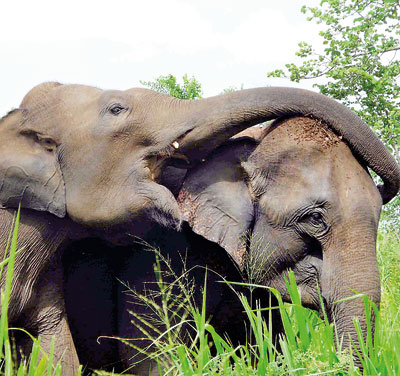News
Sri Lankan elephant families don’t have a dominant figure, study finds

Dominant behaviour: Trunk-over dominance gesture between two adult female elephants.
The accepted norm is that elephant society comprises distinct family units dominated by the oldest female, or matriarch, who adopts a central role in co-ordinating group movements and responses to threats. But recent research has revealed that this is not so with elephant families of Sri Lanka.
“We found out that unlike African savannah elephants, the Asian elephants (elephas maximus) do not exhibit clear dominance hierarchies or matriarchal “leadership,”’ researcher Dr Shermin de Silva told the Sunday Times.
Adult males are expelled and it is the females, calves and young bull elephants that form social groups. Dr de Silva studied how elephants interact within these social groups particularly observing dominance behaviors in Udawalawe National Park.
Researchers interpret ‘dominance’ as a concept indicated by behaviours such as one individual threatens, shows aggression toward another, or interferes with the other’s actions. Subordinates can be indicated by behaviours such as one individual allowing themselves to be manipulated, actively avoiding another, waiting to approach a resource until the other has moved away etc. “We have also observed specific dominance behavior such as the trunk-over gesture where the dominant puts its trunk over the head/neck/back of the subordinate,” Dr de Silva explained.
The African savanah elephant (loxodonta africana) has a matriarch, usually the oldest female. The whole group depends on the experience her wisdom to locate food and water particularly during droughts. In Africa the elephant also has natural predators such as lions that could kill young calves, so having a leader is an advantage.
But in Sri Lanka, the environment is more stable compared with Africa where food and water historically had not been difficult to come by. The elephants in Sri Lanka do not have a threat from wild predators such as tigers or lions. The researchers think that this frees up elephant individuals to make their own movement decisions, without needing to rely on the knowledge of others, or tolerate being dominated by them.
Having a clear leader also has other benefits. It will prevent unnecessary confrontations or unrest within a group.
“We suggest that in the absence of a dominance hierarchy, the Asian elephants must rely on spatial separation to avoid direct competition and conflict. When two completely unfamiliar groups meet, there can at times be physical aggression (although this is rare). So if they are constrained by being squeezed into smaller bits of habitat where they can’t get away from each other, it might lead to greater stress and conflicts,” Dr de Silva points out.
The findings also challenge other beliefs.
“It has also been sometimes assumed that social units consist of only those individuals observed together at any given time and that capturing the “matriarch” will draw other family members, ensuring their capture or cooperation. Our findings do not support such assumptions.”
These findings can be useful in elephant conservation and management. They may be important for interpreting results of previous management actions such as translocations and elephant drives that alter the social organization of populations of elephants.
Such displacements would not only disrupt long-term social bonds because social affiliates may not be close together at any given time but result in difficulties for the displaced individuals if habitats are already saturated with other elephants. Forced displacement could result in crowding and competition, with likely disproportionately negative impacts to the displaced individuals, the research found.
Dr. de Silva is now attached to the Colorado State University and the Smithsonian Institution. The study was done between 2007 and 2012 in Udawalawe and the findings were published last year. Other experts George Wittemyer and Volker Schmid too, were part of the study.
They say preserving the remaining range and its connectivity for elephants to have healthy, stress free lives should be a priority.

